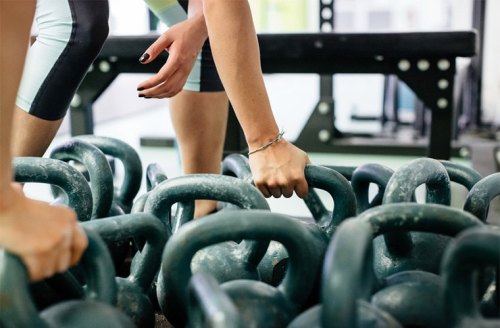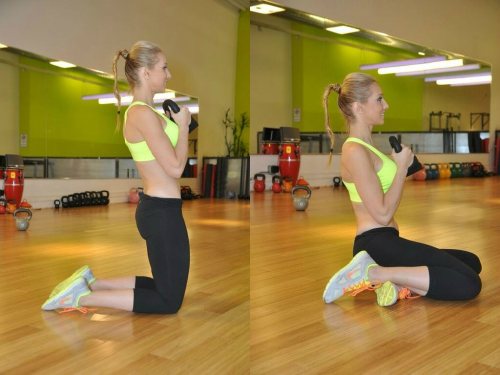Our editors independently select these products. Making a purchase through our links may earn Well+Good a commission
5 kettlebell moves for a seriously strong core
Kettlebell Kickboxing creator Dasha Libin Anderson shares a kettlebell workout for women that will lead to serious core strength.


You might be sick of trainers telling you how important core strength is…but they can’t stop because it really is incredibly crucial, says Kettlebell Kickboxing founder Dasha Libin Anderson. And not just in terms of showing off a flat stomach at the beach.
“Your core is involved in every single movement your body does—in your workouts and in your life,” says Anderson, who just released her first book, Kettlebell Kickboxing: Every Woman’s Guide to Getting Healthy, Sexy, and Strong.
Although the book includes more than 200 full-body exercises, it includes tons of ways to strengthen your abs because kettlebells are an ideal tool for the job. “The odd shape causes the weight to be distributed unevenly, and your core muscles are continuously engaged throughout every motion to control the bell’s shifting center of gravity,” Anderson explains.
In fact, one study commissioned by the American Council on Exercise found that eight weeks of training with kettlebells increased participants’ core strength by 70 (!) percent.
Ready to fire up your abs? Grab a bell at home or the gym and follow Anderson’s lead with this kettlebell workout for a seriously strong core.
Originally posted May 28, 2015. Updated July 7, 2017.
Keep reading for a kettlebell workout that will give you a seriously strong core.

The set-up
How to choose a weight: Start with one that’s challenging; aim for at least a 15-pound kettlebell. You’re distributing that weight among many muscles, not isolating one muscle group, so don’t be afraid to go heavier then you normally would.
Two different ways to do the moves:
1. Make a circuit: Execute each move for one minute, moving through all of the exercises for four rounds of nonstop action.
Beginner/Intermediate: Rest for 15–60 seconds between each exercise, depending on your fitness level. Advanced: Take 0–5 second breaks as you move on to the next exercise. Want to make it a HIIT workout? Rotate a minute of sprints, jumping jacks, and burpees between each exercise.
2. Work in sets: Beginner: Do two sets of each move, at 15–20 reps, before going on to the next exercise. Intermediate: Go for three sets of each move, at 20–25 reps. Advanced: Go for four sets of each exercise at 25–30 reps.

Side Sit-Up
Mid-rack the kettlebell (hold it in the center of your chest, as in the picture) and hold it tightly to the body. Kneel down, and then sit to the side of your knees. Continuing to hold the kettlebell to the chest, pop back up on your knees again. Then sit back down. You can alternate sides or stick to one side.
Overhead Sit-Up
Lay down on the floor with your feet spread apart. With both hands, hold the kettlebell by the horns and lift it overhead with your arms fully straight and perpendicular to the floor. Sit up, keeping your feet on the ground and your arms fixed overhead.
As you sit up, keep your gaze upwards. Then lower your body back down, being careful to use just your abs (not your shoulders, arms, or legs) to rise up. Don’t bend your arms or extend them behind or in front of you. Until the set is done, keep the kettlebell fixed overhead. You can choose to make it more difficult by holding the kettlebell in one arm, as pictured. Just don’t forget to switch sides.
Halo
Start by gripping the kettlebell around the base. Begin to move the kettlebell around your head, keeping it close throughout, and making sure it passes directly in front of your face and behind your neck. Alternate directions evenly or rotate to one side for a specified amount of time before switching directions.
Core Stabilizer
Sit on the floor with your knees bent and hold a kettlebell mid-racked (to your chest). Lean back so your torso is at a 45-degree angle to the floor, and make sure to keep your belly tight. Don’t round your lower back, and keep your shoulders straight.
Without moving your torso, slowly (take 2 seconds) rotate your shoulders to one side as far as you can, tapping the kettlebell to the floor next to your hip. Then, slowly, and with full control, turn your shoulders to the other side and tap the kettlebell. Make sure that you turn from your shoulders, not just your arms, so that your spine is stable and all of your muscles are fully engaged. Pause again, then continue to alternate back and forth.
Kettlebell Plank
Start out by getting into a push-up position with your shoulders, elbows, and wrists in a straight line. Your body should form a straight line from your shoulders to your ankles.
Place a kettlebell in front of you and with the same exact form, grip the kettlebell handle with two hands, as pictured. Keep your back, butt, and neck fully straight and aligned. Pull your belly button to your spine, and keep your glutes and core engaged by contracting your abs as if you were about to be punched in the gut. Hold this position without rounding or hanging through your back. Keep all of your muscles activated.
Here’s a killer ab workout you can do for those times when you don’t have access to any weights. Plus, what to do after a workout to maximize the benefits.
Sign Up for Our Daily Newsletter
Get all the latest in wellness, trends, food, fitness, beauty, and more delivered right to your inbox.
Got it, you've been added to our email list.










